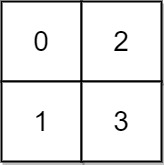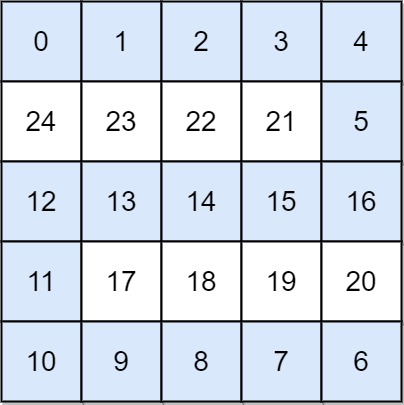LeetCode in Kotlin
778. Swim in Rising Water
Hard
You are given an n x n integer matrix grid where each value grid[i][j] represents the elevation at that point (i, j).
The rain starts to fall. At time t, the depth of the water everywhere is t. You can swim from a square to another 4-directionally adjacent square if and only if the elevation of both squares individually are at most t. You can swim infinite distances in zero time. Of course, you must stay within the boundaries of the grid during your swim.
Return the least time until you can reach the bottom right square (n - 1, n - 1) if you start at the top left square (0, 0).
Example 1:

Input: grid = [[0,2],[1,3]]
Output: 3 Explanation:
At time 0, you are in grid location (0, 0).
You cannot go anywhere else because 4-directionally adjacent neighbors have a higher elevation than t = 0.
You cannot reach point (1, 1) until time 3.
When the depth of water is 3, we can swim anywhere inside the grid.
Example 2:

Input: grid = [[0,1,2,3,4],[24,23,22,21,5],[12,13,14,15,16],[11,17,18,19,20],[10,9,8,7,6]]
Output: 16
Explanation: The final route is shown. We need to wait until time 16 so that (0, 0) and (4, 4) are connected.
Constraints:
n == grid.lengthn == grid[i].length1 <= n <= 500 <= grid[i][j] < n2- Each value
grid[i][j]is unique.
Solution
import java.util.LinkedList
import java.util.Queue
class Solution {
private val dir = intArrayOf(-1, 0, 1, 0, -1)
fun swimInWater(grid: Array<IntArray>): Int {
var max = 0
// find the maximum value in the matrix
for (ints in grid) {
for (j in grid[0].indices) {
max = max.coerceAtLeast(ints[j])
}
}
var l = 0
var r = max
var res = 0
// perform binary search
while (l <= r) {
// find test water level
val mid = (l + r) / 2
// if you can reach destination with current water level, store it as an answer and try
// lowering water level
if (bfs(grid, mid)) {
res = mid
r = mid - 1
} else {
// otherwise increase water level and try again
l = mid + 1
}
}
return res
}
private fun bfs(grid: Array<IntArray>, limit: Int): Boolean {
// use queue to process cells starting from top left corner
val que: Queue<IntArray> = LinkedList()
// boolean array to keep track of visited cells
val visited = Array(grid.size) {
BooleanArray(
grid[0].size,
)
}
// we start from top left corner
que.add(intArrayOf(0, 0))
visited[0][0] = true
while (que.isNotEmpty()) {
// get current cell
val cur = que.poll()
val x = cur[0]
val y = cur[1]
// if value of current cell is greater than limit return false
if (grid[x][y] > limit) {
return false
}
// if we reached the destination return true
if (x == grid.size - 1 && y == grid[0].size - 1) {
return true
}
// check cells in all 4 directions
for (i in 0 until dir.size - 1) {
val dx = x + dir[i]
val dy = y + dir[i + 1]
// if neighboring cell is in bounds, and hasn't been visited yet,
// and its value is less than current water level, add it to visited array and to
// the queue
if (dx >= 0 && dy >= 0 && dx < grid.size && dy < grid[0].size &&
!visited[dx][dy] && grid[dx][dy] <= limit
) {
visited[dx][dy] = true
que.add(intArrayOf(dx, dy))
}
}
}
return false
}
}

